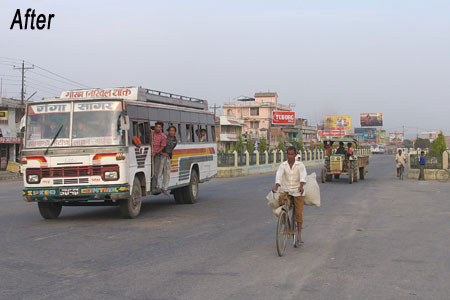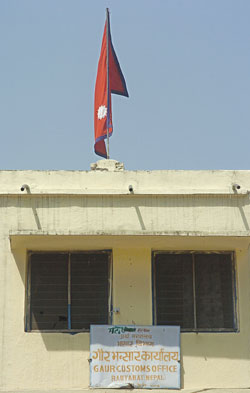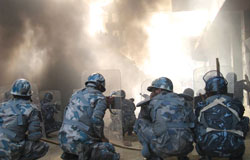|
|
| HIGHWAY INFERNO: Seventeen parked buses were torched in Lahan on 18 January this year by madhesi activists. The same spot on Thursday afternoon (below). |
|
|
|
|
| HOLDING FIRM: There aren\'t daily pitched battles between madhesi activists and armed police in the streets as in January (below), and government offices in the eastern tarai still fly the Nepali flag. But the government on the signboard is that of the \'Madhes\'. |
Nearly three months after they witnessed an unprecedented explosion of violence, the towns of the central and eastern tarai are limping back to normal. But the ethnic polarisation of Nepal's plains may be an enduring legacy.
Here in Lahan where it all started in mid-January, many hill residents who fled back then have returned. Protests by the Madhesi Janadhikar Forum (MJF) do not seem to have the same energy these days, especially after the Tharus refused to join, following the massacre of Maoists in Gaur three weeks ago. The sekuwa shops are open, and night buses roar through town all night.
But the atmosphere is still charged, cross-border crime is widespread and there is a general sense of lawlessness. Kidnappings for ransom, mainly of hill people by one of the tarai militant groups, are a daily occurrence. Attacks and death threats against journalists have forced many to move out. Few think proper elections can be held in June.
"Things will never be the same again," says one Lahan resident, "Nepal is now divided and the border is the east-west highway."
Indeed, election politics and new ethnic polarisation can create a volatile mix in Siraha and its adjoining districts as campaigning for elections heat up. The Chure-Bhabar agitation is a direct response to a militant madhes and represents the interests of the Tamang, Magar and other hill-ethnic groups that live along or north of the highway.
Meeting madhes demands for re-demaraction of constituencies by plains people will short-change hill dwellers, and vice-versa. Highway towns like Lahan are where these interests intersect, and delineating voting units north-south will favour madhesis while hill ethnics living here will benefit from an east-west arrangement. All this is made much more complicated by past gerrymandering.
The most direct impact of the last three months is that the Maoists are now 'internally displaced people' from the eastern tarai, and everyone who didn't like them (from royalist land-owners to local political party cadre) are happy with that. Nearly everyone here agrees that it was the Maoists who sparked off the protests with the killing of a madhesi activist on 18 January, and then made matters worse by spiriting away his body.
|
|
Now, with elections in the air, the MJF is fading away just as suddenly as it appeared, and madhesi leaders of the political parties who took up the Forum's slogans during the agitation are back in their parties.
Militant madehsi groups like the two factions of the JTMM are at the forefront again. Besides kidnappings and bombings, one of them has called for a tarai shutdown on 9 April, demanding an end to Kathmandu's 'colonial rule' of the plains.
Unlike the rest of Nepal which has experienced a year of ceasefire, the war never ended here. With the new ethnic rift and an unstable election up ahead, it doesn't look like the eastern tarai will see real peace anytime soon.






